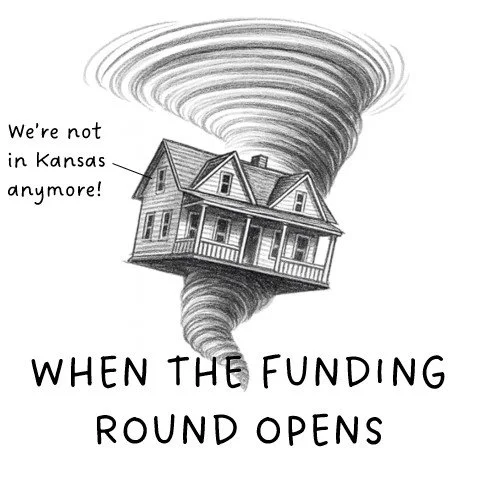Make it rain: building an investable story
Funding flows where confidence lives
“Make it rain” is slang for bringing in money. In my world, it means securing the funding and approvals that turn a promising idea into an investable story.
Make it rain is my shorthand for creating confidence - the lever that helps investors, governments, and communities see why something is worth backing. It’s not just about filling in forms or chasing grants. It’s about building a story that reflects the priorities of everyone who matters, so that funding flows in the right direction, to the right people, and creates it’s own special brand of momentum.
Load-bearing windows
Before a shovel can even get a whiff of readiness, money has to be in the mix. And to make that happen, the first kind of build that has to happen is the one in people’s heads.
That build starts with active listening to surface what people with controlling interests in your work actually care about. I think of it as constructing a house with many windows. Treasury looks through one and sees fiscal prudence. Ministers look through another and see political alignment. Communities look through theirs and see what’s in it for them. Delivery leads look through theirs and see feasibility. Every window has its own view, but they all belong to the same house.
Those views rarely align neatly. One might highlight savings, another costs. Speed versus risk, community benefit versus timeframes. This tension is normal, natural, and exactly why we’re building this house. The work is to balance all the views into a coherent story so that everyone sees the same structure standing firm. When investors feel their perspective has been acknowledged and considered alongside others, their confidence grows. And confidence is what unlocks the cashola.
People often dismiss this stage as fluffy, as though it’s all talk, no action. In reality though, it’s the load-bearing part of the whole build. Get it right and you’ve got the foundations investors, governments, and communities can stand on. Skip it, and your awesome idea collapses under the weight of good intentions.
The ultimate real-world test: Northern Rivers recovery
I found out all about it when I went to work on the recovery of the Northern Rivers after the 2022 floods. It was a $150m federal government pledge, requiring three layers of government to work in sync with multiple NGOs and communities to pick up their lives after suffering a huge disaster. Hard is an understatement.
It goes without saying that the views were diverse, the voices loud, and the constraints very real. Communities needed their trauma recognised and their voices heard. The feds pushed for pace, keen to see projects underway. NSW government focused on probity and process. Councils wanted funds flowing quickly to keep local workforces active, but also more support to deliver the largest infrastructure programs they’d ever faced. Everyone wanted assurance the spend would withstand scrutiny, shaped by lessons from the 2019 bushfires.
Each perspective had the power to slow progress. Instead, framing them into a unified end-goal made the planning pathway clearer and the funding process faster. Sequenced tranches gave councils confidence to deliver early wins. Tripartite governance reassured ministers and auditors. A clear Aboriginal engagement strategy built trust with communities. Together, these moves unlocked agreements for 36 projects with the first breaking ground inside eight months.
Tick the right boxes with heart
So this is what making it rain looks like in practice: surfacing every perspective, balancing them into a coherent story, and giving funders the confidence to let money flow quickly into delivery. Funding bodies, whether public, philanthropic, or private, each bring their own pressures and accountabilities. Understanding those pressures and weaving them into the story is what makes a project fundable.
If this resonates with the work you’re doing, I’d love to hear how you approach making it rain in your world.
The next article in this series drops 23 September. In Happy investors I’ll explore how to keep funders supportive once the money is on the table.
